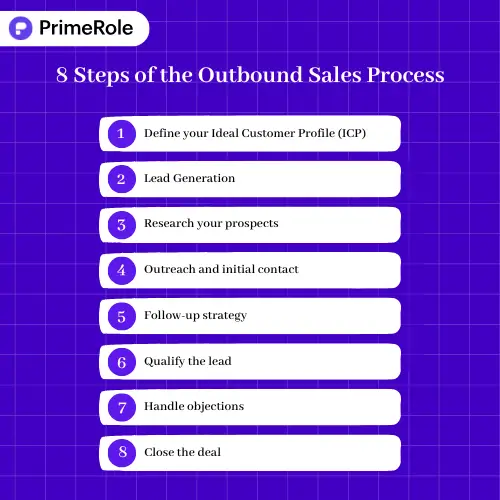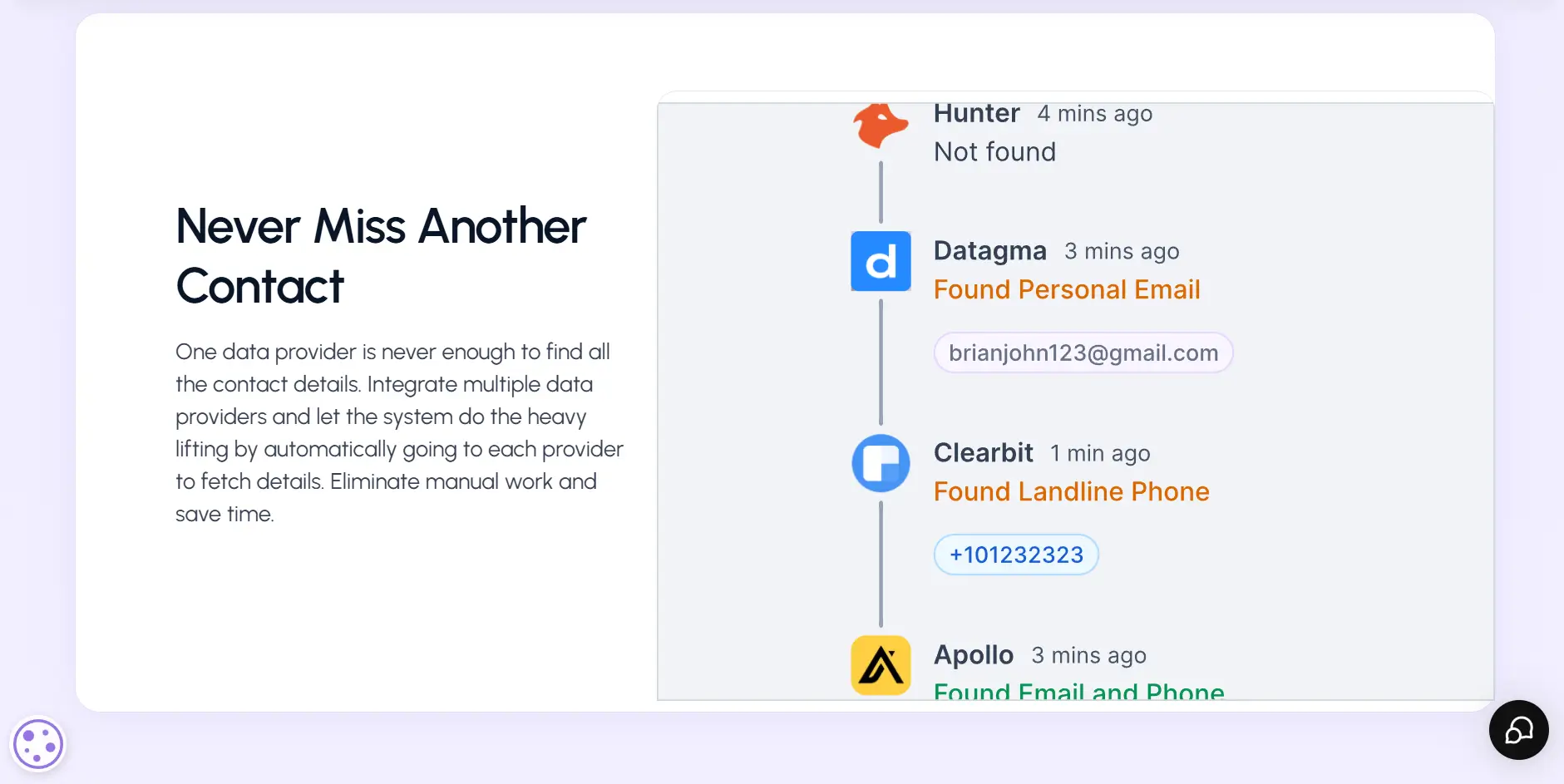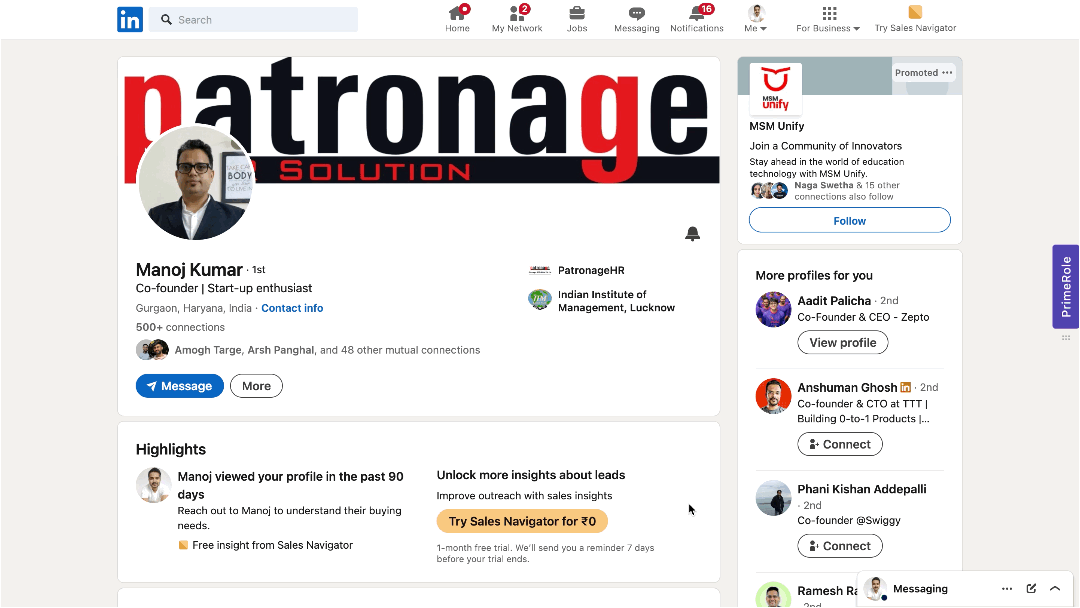
Outbound sales is a process in which sales reps take the first step in contact with potential customers who haven’t previously expressed interest in your product or service. Instead of waiting for leads to discover your solution, you actively initiate contact through strategies like account based selling (ABS), cold calling, cold emailing, or LinkedIn outreach.
According to RAIN Group, 82% of buyers accept meetings when sellers reach out to them first, proving that thoughtful outbound outreach still opens doors. Whether you’re part of a fast-scaling B2B team or looking to refine your outbound motion, this guide will break down the what, why, and how of outbound sales to help you confidently close more deals.
Table of Contents:
- Outbound Sales Definition
- What are the Benefits of Outbound Sales?
- 8 Steps of the Outbound Sales Process
- What are the Effective Outbound Sales Strategies?
- 5 Key KPIs for Measuring Outbound Sales Performance
- Difference between Outbound Sales and Inbound Sales
- Conclusion
- Outbound Sales Frequently Ask Questions (FAQs)
Outbound Sales Definition
Outbound sales is a deliberate, targeted strategy in which a company contacts prospects outside of their existing network to generate leads and close deals. It’s commonly used in B2B, especially in industries with long sales cycles or high-value deals.
Supercharge Your Sales with Actionable Insights!
Transform your sales growth with PrimeRole verified data and AI-enriched company insights
What are the Benefits of Outbound Sales?
The specifics may vary based on your industry or company size, but the core truth holds across the board. Outbound sales is a crucial driver of new business. It empowers your sales team to initiate conversations, connect directly with high-value prospects, and build a predictable pipeline that aligns with revenue goals.
Here are some of the most compelling benefits of incorporating outbound techniques into your overall sales strategy:
Precisely Targets the Right Audience
Outbound sales puts you in control of who you pursue. Your team creates a highly detailed Ideal Customer Profile (ICP) using firmographic data such as industry, company size, challenges, and goals. With this blueprint, they can zero in on leads most likely to benefit from your solution.
This precision enables reps to deliver personalized, relevant messaging that addresses actual pain points. Instead of vague, broad outreach, every interaction has a purpose, making your outreach efforts intentional and impactful.
Accelerates Pipeline Creation
Your sales reps don’t have to wait around for someone to visit your website or download an eBook. With outbound, they actively generate opportunities right away. They engage with potential customers on their timelines through emails, LinkedIn messages, or cold calls.
This proactive technique speeds up pipeline growth. Reps can connect with more qualified leads in a shorter timeframe and create momentum from day one.
Prompts Faster Buyer Responses
By initiating contact, your reps can immediately identify the prospect’s pain points and offer solutions tailored to their needs. This creates opportunities for real-time dialogue, where reps can address objections, answer questions, and spark interest on the spot.
Outbound selling often leads to shorter sales cycles. Since your reps aren’t waiting for passive engagement, they accelerate the decision-making process and move deals forward faster.
Delivers Predictable and Scalable Lead Generation
With structured outreach sequences and clearly defined workflows, your outbound sales team builds a scalable system that consistently brings in leads. It’s a strategic numbers game. More high-quality outreach equals more conversations and conversions.
This predictability allows your team to forecast sales activity, manage resources efficiently, and build a repeatable model that grows alongside your business.
Strengthens Rapport and Relationship Building
Outbound reps form relationships from the very first touchpoint. These initial conversations provide valuable insight into the prospect’s challenges and preferences, allowing reps to tailor follow-ups and offer guidance beyond selling.
Instead of sounding like another vendor, your reps become trusted advisors. This level of connection is hard to achieve with inbound alone, where the first point of contact might be a gated piece of content or a chatbot.
Supports Continuous Optimization Through Data
Outbound sales are rich with actionable data. Every click, open, reply, and meeting is trackable. Your sales leaders can monitor performance metrics and spot patterns that indicate what works and what doesn’t.
This transparency allows for ongoing experimentation, refinement, and improvement. Reps can adjust their messaging, timing, and targeting strategies based on real feedback, making the outbound motion more innovative and efficient.
8 Steps of the Outbound Sales Process
Creating an outbound sales process tailored to your business is essential for consistent growth. While every team will have its own nuances, these eight foundational steps can help you in building a high-performing outbound strategy:

1. Define your Ideal Customer Profile (ICP)
Outbound sales works best when you know exactly who you’re targeting. Instead of casting a wide net and hoping for the best, focus on those who are most likely to benefit from your product.
Start by crafting an Ideal Customer Profile (ICP). This includes firmographics like company size, industry, revenue, and job titles, as well as key challenges your solution can solve. Use real customer data, internal insights, and market research to fine-tune your ICP. This ensures your sales team speaks to the right audience from the start.
Reach Your Ideal Prospects with Precision
Utilize PrimeRole's advanced tools to identify, target, and engage your customers effortlessly.
2. Lead Generation
Once your ICP is in place, it's time to build your list of potential buyers. You can collaborate with your in-house lead generation team, purchase verified lead lists, or take a hands-on approach using tools like LinkedIn, web directories, and intent data platforms.
To enhance lead quality, consider using PrimeRole’s b2b sales intelligence platform. Its multi-provider waterfall enrichment feature allows you to verify and enrich lead information in real-time, helping you eliminate outdated or inaccurate records and prioritize high-quality contacts.
Log every enriched lead into your CRM, so your team can track engagement, stay organized, and guide prospects seamlessly through the pipeline.

3. Research your prospects
Before reaching out, do your homework. The more personalized your outreach, the better the chances of sparking a conversation. Look into the company’s recent news, the prospect’s role, team size, or mutual connections.
Check out their social media activity and website. This research allows you to tailor your messaging to their specific goals and challenges, making your pitch more relevant and engaging.
4. Outreach and initial contact
Now, you’re ready to make the first move. Cold emailing and cold calling are traditional go-to's, but you can also engage prospects via LinkedIn, Twitter, or other platforms they frequent.
Whichever channel you use, your outreach should be concise, personalized, and value-driven. Instead of diving into a hard sell, start a conversation about their pain points and how you can help.
5. Follow-up strategy
Most leads do not respond to the first communication, which is normal. However, a solid follow-up approach can mean the difference between a completed transaction and a missed opportunity.
Plan a multi-touch follow-up strategy that includes emails, phone calls, and social media interactions. Mix up your messaging to provide value to each engagement, whether by sharing an insight, a case study, or asking an insightful question. Consistency and persistence are essential.
6. Qualify the lead
Once you’ve made contact, it’s time to determine whether this prospect is a good fit. That’s where lead qualification comes in. Use frameworks like BANT (Budget, Authority, Need, Timing) to evaluate whether they’re ready and able to buy.
Ask thoughtful questions to uncover whether your solution aligns with their business goals and timeline. A well-qualified lead saves time and increases your conversion rate down the line.
Qualify High-Value Prospects Instantly
Optimize lead scoring with PrimeRole’s AI-driven ICP qualification system
7. Handle objections
Objections are a normal part of sales. Whether it’s pricing, timing, or competing priorities, your job is to listen carefully and address concerns with empathy and clarity.
This is where your prep work pays off. Use data, success stories, and personalized insights to reassure prospects and guide them past hesitation. The key is to position yourself as a problem-solver, not just a seller.
8. Close the deal
If you’ve made it this far, you’re close to the finish line. Now it’s time to present your offer, walk through the proposal, and help your prospect make a confident buying decision.
Be clear about pricing, next steps, and implementation. Offer support throughout the process and make it easy for them to say “yes.” Once closed, ensure a smooth handoff to customer success so they have a great onboarding experience.
What are the Outbound Sales Strategies?
The success of your marketing initiatives is heavily dependent on the effectiveness of your outbound sales tips. Therefore, it is essential to use the most effective strategies to ensure positive outcomes.
Here are a few effective outbound sales strategies to begin with:
1. Account-Based Selling (ABS)
Account-Based Selling is a strategic approach that targets specific high-value accounts rather than using a broad approach to sell to many. In ABS, sales teams collaborate closely with marketing to understand the unique pain points and needs of each account.
This personalized outreach might include tailored content and customized communications that resonate with multiple decision-makers within the organization. The focus on building relationships and aligning messaging helps increase engagement and, ultimately, conversion rates.
2. Cold Email Outreach
Cold email outreach remains one of the most widely adopted and effective outbound sales techniques. This method involves sending personalized emails to potential prospects who haven’t previously interacted with your brand.
The core objective is to introduce your business and spark curiosity in your product or service. When crafted carefully, cold emails help build credibility, create meaningful conversations, and ultimately improve lead conversion.
Successful cold emailing begins with deep research. Your email must reflect an understanding of the recipient’s pain points or goals. By offering a solution or value in the message, you increase your chances of getting a reply.
To ensure effective performance, track key metrics such as:
- Open Rate: To measure subject line effectiveness and email deliverability.
- Reply Rate: Indicates interest level and how compelling your message is.
- Conversion Rate: Shows how many replies led to actual opportunities or sales.
You can further streamline your cold emailing process by using automation tools that support bulk sending, personalization, and real-time analytics.
3. LinkedIn Cold Outreach
LinkedIn is an effective tool for B2B outreach and professional networking. It enables sales teams to connect directly with decision-makers, broaden their business network, and establish rapport through individualized engagement.
With LinkedIn cold outreach, you can send tailored connection requests and initiate one-on-one conversations with prospects. Unlike generic emails, LinkedIn messaging feels more human and less intrusive, making it ideal for starting business discussions.
Once a prospect accepts your connection, you can share insights, content, or ask relevant questions to keep the conversation going. Over time, this builds trust and allows you to introduce your solutions when the time is right.
This method typically results in:
- Higher acceptance and response rates.
- Better targeting of qualified leads.
- Long-term relationships that lead to referrals and sales.
LinkedIn also allows you to track who viewed your profile or engaged with your posts; perfect signals for outreach timing.

4. Cold Calling
Cold calling is a traditional outbound sales technique that still holds value in the digital age. It involves direct phone conversations with potential leads to introduce your product or service and initiate a sales dialogue. The benefit of cold calling is the immediate, real-time interaction.
It allows you to listen actively to your prospect’s needs and tailor your pitch accordingly. The more engaging and value-focused the conversation, the more likely it is to turn into a qualified opportunity. Sales teams typically use auto-dialers or CRM integrations to manage call lists efficiently. These tools help streamline workflows and improve call productivity.
A successful cold call is not about pushing a sale but about sparking curiosity and leaving a strong first impression. Even if the lead doesn’t convert immediately, a well-handled call can set the stage for future engagement.
5. Multi-Channel Outreach
Relying on a single communication method can limit your reach. Multi-channel outreach combines various platforms such as email, phone calls, LinkedIn, SMS, and even direct mail to increase your chances of connecting with prospects.
This strategy ensures your brand remains visible and top-of-mind across different touchpoints. For example, you might follow up an email with a LinkedIn message or a phone call, creating a cohesive and persistent outreach experience.
Benefits of multi-channel outreach include:
- Higher engagement rates from varied outreach styles.
- Stronger brand presence and recall.
- Increased opportunities to nurture and convert leads.
Multi-channel strategies are particularly effective when paired with sales automation platforms that allow you to manage cadences, timing, and messaging across all channels.
6. Intent-Driven Prospecting
Intent-driven prospecting involves targeting leads based on their behavior, online activity, or buying signals. These signals may include website visits, content downloads, or even company news like funding rounds or hiring sprees.
By understanding which prospects are actively researching solutions, you can prioritize outreach and tailor messaging to match their current needs. This not only boosts efficiency but significantly improves lead quality.
For example, if a prospect has recently engaged with your blog or pricing page, that’s a strong signal of interest. Reaching out at the right time, with the right message, increases the likelihood of securing a meeting or demo.
Intent data can be gathered through website analytics tools, third-party data providers, or marketing automation platforms. Leveraging this strategy ensures your outreach is timely, relevant, and impactful.
Engage Your Buyers with Personalized Precision
Use PrimeRole to pinpoint personas, personalize outreach, and boost engagement effortlessly.
5 Key KPIs for Measuring Outbound Sales Performance
There are many KPIs that help measure outbound sales success. But not every metric works equally well for every business. The key is to identify the indicators that align with your goals, sales process, and team structure.
However, five core KPIs that every outbound sales team should consider tracking include:
1. Number of outbound calls or emails sent
This metric reflects the total volume of outbound outreach efforts such as calls, emails, or social messages made by your sales reps. It gives you visibility into how much effort your team is putting into generating leads. A consistently high volume typically indicates a disciplined sales process.
However, quantity alone isn’t enough. You’ll need to balance it with other KPIs to measure effectiveness. If outreach numbers are low, it’s often a sign that pipeline growth may slow down in the near future.
2. Connect rate
Connect rate measures how many of your outbound attempts result in real-time conversations with prospects. This could be someone answering a phone call or replying to an email. A strong connect rate indicates that you’re reaching the right people at the right time, while a low rate may suggest poor targeting, ineffective messaging, or wrong timing. Improving this metric often involves refining your contact list, personalizing messages, and optimizing the time of outreach.
3. Conversion rate
Conversion rate refers to the percentage of connections that turn into qualified leads or booked meetings. It’s a critical indicator of how well your team is doing once they get someone’s attention. A high conversion rate means your sales reps are persuasive and handle conversations effectively. On the other hand, a low rate might suggest the need for better sales scripts, objection handling, or more precise targeting.
4. Average deal size
Average deal size tracks the average value of each closed sale that originates from outbound efforts. It helps you understand the quality of the leads your team is engaging with. If your average deal size is growing, it often means your team is getting better at identifying and converting high-value opportunities. Conversely, if it’s shrinking, it could indicate that your outbound efforts are attracting smaller or less suitable accounts.
5. Sales cycle length
Sales cycle length measures the time it takes to move a lead from initial contact to a closed deal. This KPI helps assess the efficiency of your sales process. A shorter sales cycle typically indicates a well-oiled machine where prospects are qualified, nurtured, and converted quickly. If your sales cycle is getting longer, it may be worth examining your follow-up processes, lead quality, or where deals are stalling in the funnel.
Difference between Outbound Sales and Inbound Sales
The difference between inbound and outbound sales lies in how the customer is engaged and who initiates the conversation. Here's a breakdown:
| Criteria | Inbound Sales | Outbound Sales |
|---|---|---|
| Sales Strategy | A pull-based method where leads discover and approach your business through content, SEO, or referrals. | A push-based approach where sales reps proactively reach out to potential leads via direct contact. |
| Lead Engagement | Prospects initiate contact after interacting with value-driven content or campaigns. | Sales reps make the first move, targeting prospects through emails, calls, or LinkedIn messages. |
| Content Type | eBooks, whitepapers, case studies | Blog posts, videos, industry reports, infographics |
| Audience Targeting | Targets a broader group actively seeking solutions, often driven by search intent. | Focuses on a specific audience that fits the ideal customer profile, often through curated outreach. |
| Lead Acquisition | Depends on content marketing, website forms, webinars, and organic channels. | Relies on prospecting tools, lead databases, cold outreach, and outbound sequences. |
| Sales Cycle Duration | Typically shorter, as leads are pre-qualified and show higher buying intent. | Often longer, requiring time to build interest and trust with cold leads. |
| Cost Efficiency | More cost-effective in the long term due to automation and organic growth. | Usually costlier, involving paid tools, ad spend, and manual outreach efforts. |
Conclusion
Outbound sales isn't just a growth lever; it's often the fastest route to revenue. Whether you're a lean startup or a scaled B2B organization, outbound selling gives your team the power to take control of the pipeline, connect directly with decision-makers, and spark high-value conversations.
See how PrimeRole can help you build a smarter outbound engine. Reach out today to discover how we empower reps with data, automation, and insights that close deals.
Outbound Sales Frequently Ask Questions (FAQs)
What is an outbound sales campaign?
An outbound sales campaign is a structured series of messages sent via email, calls, and social platforms to a target list of prospects, aiming to generate interest and book meetings.
What makes a good outbound sales rep?
Outbound sales techniques encompass cold calling, cold emailing, and LinkedIn outreach for professional engagement. Personalized video outreach is becoming popular, offering a more human touch and creating engaging first impressions with potential customers.
What are some common outbound sales techniques?
A good outbound sales rep possesses excellent communication skills, persistence to follow up consistently, and empathy to understand a prospect’s pain points. They should also be skilled researchers, able to tailor messaging for each lead, and adept with tools that help personalize and automate outreach efficiently.
What does an outbound sales job description typically include?
An outbound sales job description usually includes responsibilities like cold calling, lead generation, following up with prospects, scheduling meetings, and maintaining CRM records. It also outlines required skills such as strong communication, time management, and familiarity with outbound tools like Salesloft or Outreach.
